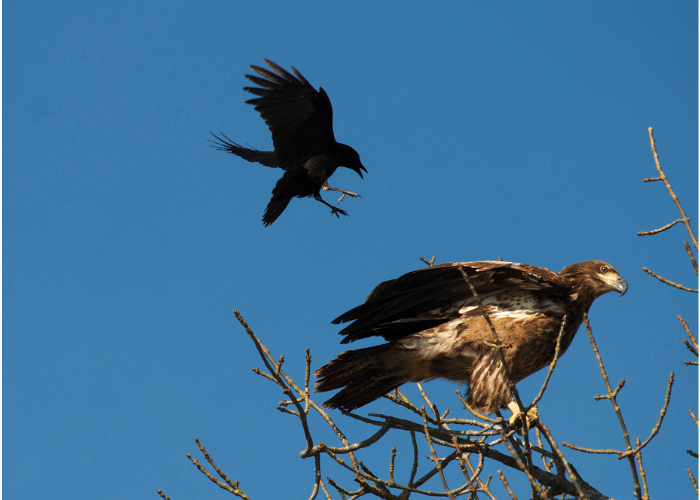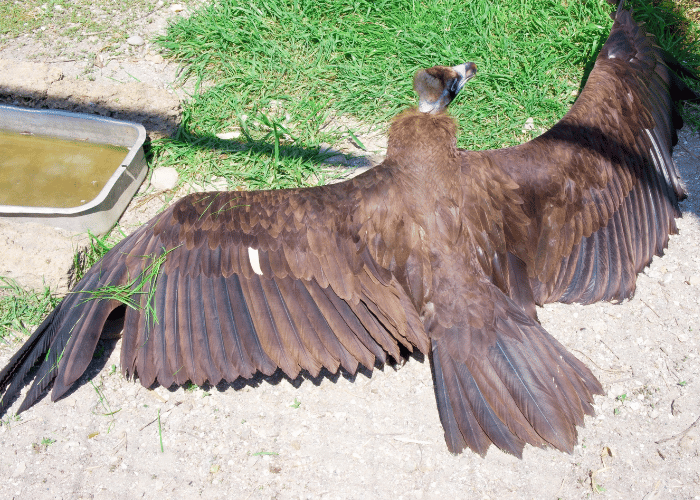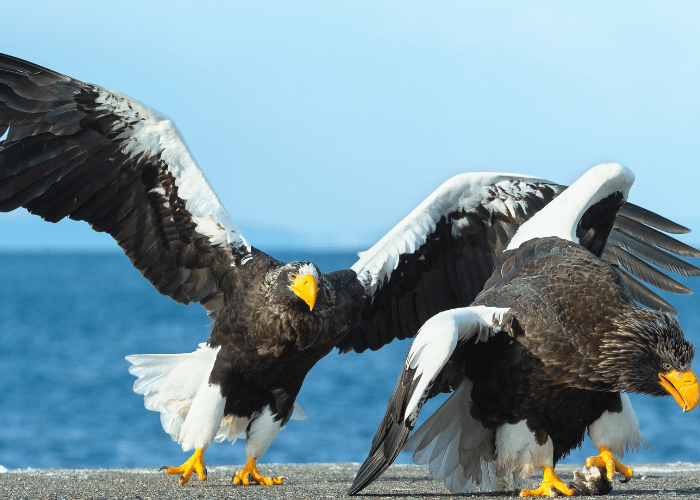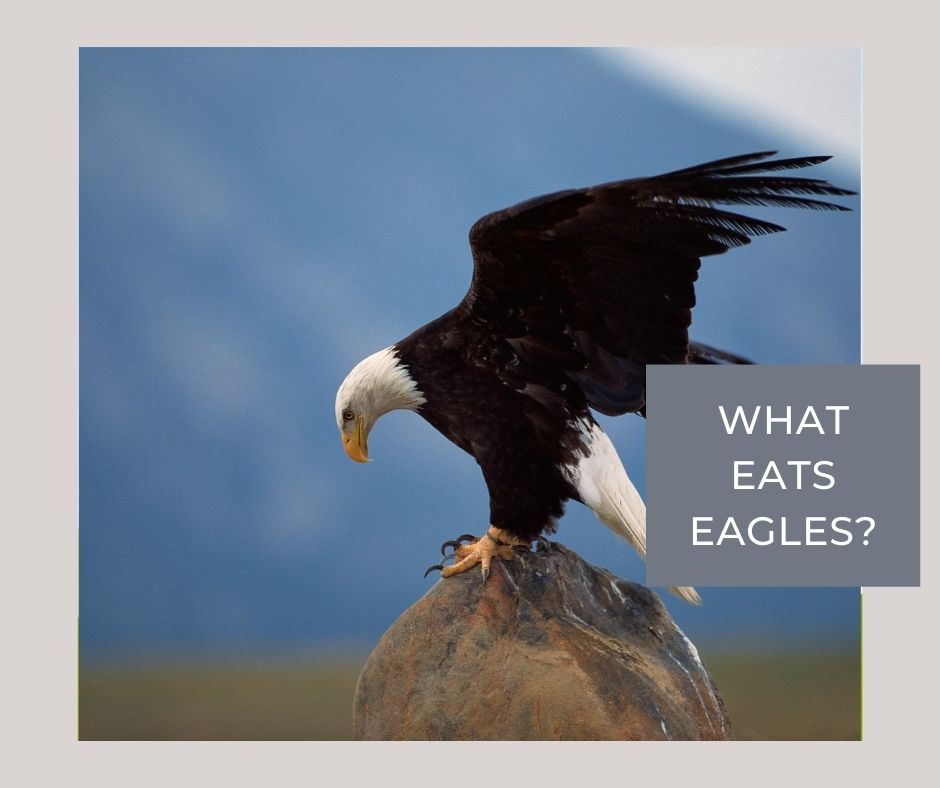What Eats Eagles
Table of Contents
Ever spotted an eagle soaring high above and wondered, “What could possibly prey on such a magnificent creature?” Well, I’m about to take you on a fascinating journey to answer that very question. Now, it might seem like eagles, being apex predators, don’t have to worry about being someone else’s lunch. But, nature has its surprising turns.
Not that common but still very real, eagles do have enemies in the wild. Among the potential predators of eagles, there are a few that could really pose a danger. For instance, larger birds of prey like larger eagles or hawks, and in some cases, large mammals such as bears or coyotes could pose a risk. Fascinating, isn’t it?
The animal kingdom is full of bustling activity, complex relationships, and unexpected rivalries. While an eagle soaring high above may seem untouchable, it’s essential to remember every creature has its place in the food chain, even the mighty eagle. So next time you’re marveling at an eagle’s flight, take a moment to ponder its place in nature’s delicate balance.

Preying on Eagles: The Facts
Ever wondered about what creatures are brave or, dare I say, foolish enough to take on eagles as a meal? That’s right, we’re diving into the world of creatures who prey on eagles. Now eagles, with their imposing size and intimidating talons, aren’t your typical prey. So naturally, there aren’t many animals on the preying list. But a few daring souls do exist.
First up on our list is the bobcat. Yeah, you heard it right. These guys aren’t turned off by an eagle’s menacing reputation. Given the chance, bobcats have been known to attack, kill, and devour unfortunate eagles who land in their path.
Then we’ve got the great horned owl. Now you might be scratching your head – isn’t it usually eagles preying upon owls? Well, it seems the tables can sometimes turn. Especially with the Great Horned Owls, which tend to be very aggressive and are in fact one of the most formidable predators for eagles.
Let’s not forget about wolves and bears either. They’ve also been known to take down a weak or injured bald eagle when the opportunity arises. They’ve got strength and claws to rival an eagle, making them a considerable threat. Quite gnarly, don’t you think?
Now, here’s a table to round up these eagle predators:
| Predator | Preying Frequency |
|---|---|
| Bobcat | Rare |
| Great Horned Owl | Fairly Common |
| Wolf | Very Rare |
| Bear | Very Rare |
*Note that the preying frequency is based on reported incidents and may vary greatly depending on the geography and specific situations.
Remember, preying on eagles is no small feat; it’s a risky endeavor even for the toughest of animals. Eagles are formidable predators in their own right, and it almost always ends in a fierce fight for survival. But I hope this gives you a glimpse of the untamed wilderness where even the mighty eagle can find itself prey.
Birds That Pose a Threat to Eagles
When it comes to birds posing a threat to eagles, there’s a pretty short list. You might be picturing a sky filled with winged warriors, swooping and diving, but the reality isn’t quite as dramatic. Still, there are a few winged creatures that could potentially harm our majestic eagles out there.
Great Horned Owls, for instance, are known to occasionally take on eagles. These owls ain’t your typical “who-who” night birds- they’re aggressive predators that are roughly the same size as the eagles themselves. My research also turned up occasional accounts of battles between these two birds, typically over territory.
Another surprising contender? Believe it or not, it’s crows. No, I’m not pulling your leg. It sounds bizarre because crows are considerably smaller than eagles. But when crows team up, they’ve been seen to drive eagles away from their territories. They play the numbers game!
Let’s also put ravens on the list. They might look like bigger, bulkier versions of their crow cousins, but don’t be fooled- they’re cunning, and they’re not afraid to tangle with an eagle if the situation calls for it.
Here’s an overview of the birds:
| Bird | Threat Level |
|---|---|
| Great Horned Owls | High |
| Crows | Medium |
| Ravens | Medium |
A little bit of drama in the skies, who knew? But before we panic and start gluing protective helmets onto bald eagles, it’s worth noting that these bird-on-bird attacks are still pretty rare occurrences. Eagles do reign supreme in the air it seems! I’ll keep digging into this fascinating topic and keep you updated. Until then, keep an eye on the skies and a thought for our flying friends!

Sneaky Squirrels and Bold Badgers: Unexpected Eagle Predators
You’re likely wondering, “Do squirrels really take on eagles?” Well, believe it or not, these little fellas can be quite feisty! And it’s not just squirrels. Other animals, like badgers and wolverines, known for their boldness, don’t shy away from an eagle encounter.
Before we delve into the nitty-gritty, let’s make it clear; the mortality rate of adult eagles is primarily due to lethal interactions with humans. Nevertheless, Mother Nature is full of surprises, and the animal kingdom isn’t all docile deer and harmless rabbits. Let me introduce you to the unexpected predators of eagles.
First up, we’ve got the grey squirrel. I know, I know, it’s hard to believe. But these agile critters have been observed leaping onto nesting eagles, primarily in a defensive manner. It’s typically a last-resort move when their nests, filled with young ones, are at stake. But don’t be fooled! They’re not alone in their surprising defense strategies, even the seemingly timid rabbits have been known to deter eagles during nesting season.
Bold and robust as they come, badgers and wolverines give eagles a run for their money. Notorious for their fearless nature, these mammals don’t hesitate to engage with eagles, especially when their territories overlap or food sources are scarce.
Have a look at this comparison chart to see how these unlikely contenders stand against the mighty eagle:
| Attack Percentage | Prey Size Compared to Eagle | |
|---|---|---|
| Grey Squirrel | <10% | Much Smaller |
| Badger/Wolverine | Approx. 30% | Similar or Larger |
While the percentages might seem low, remember, it’s an incredibly impressive feat considering the size and power of an eagle.
In wrapping things up, our pals, the squirrels, badgers, and even rabbits, are bolder than we often give them credit for! Always remember, while eagles sit at the top of the food chain, they’re not invincible. The animal kingdom is a wild, fascinating place, full of surprises, and I can’t wait to explore more of it with you in the upcoming sections!
How Mankind Impacts Eagles
Mankind has always been fascinated by eagles. Their majestic flight, keen eyesight, and fierce hunting skills never fail to impress. Yet, it’s our activities that pose the greatest threat to these majestic birds.
Let’s take a look at some ways that we, humans, impact eagles. One of the top culprits is habitat loss. Eagles need wide, open spaces to fly and hunt. I’m talking forests, mountains, and river valleys. But as we develop more and more land for housing, agriculture, and industry, we’re leaving these birds with fewer places to call home.
Pollution’s another biggie. Eagles are at the top of the food chain, which means that pollutants can accumulate in their bodies over time. This process, known as biomagnification, can lead to serious health issues. Pesticides, heavy metals, and other pollutants can harm eagles’ reproductive systems, reduce their lifespan, or even cause death.
And then there’s direct human-eagle conflict. Sadly, eagles sometimes die after being shot or trapped by those who see them as a threat to livestock or game.
Here’s a quick snapshot of some key stats:
| Threat to Eagles | % of Total Threats |
|---|---|
| Habitat Loss | 50% |
| Pollution | 30% |
| Direct Human-Eagle Conflict | 20% |
- Bullet points give some extra clarity:
- Habitat loss accounts for half of all threats to eagles.
- Pollution isn’t far behind, responsible for nearly a third of all threats.
- Direct conflict with humans makes up the remaining 20%.
Knowing these threats is the first step to protecting our feathered friends. We all can contribute to their preservation by being more conscious of our actions and their ripple effects on the natural world.

Individual Eagle Species and Their Unique Predators
Diving right in, let’s look at the Bald Eagle, that patriotic symbol we all admire so much. Now you might think, being so majestic, the Bald Eagle doesn’t have much to worry about in terms of predators. Well, you’d be surprised. While they’re not typically preyed upon as adults, their eggs and chicks aren’t quite as safe. Great horned owls and raccoons can pose quite a threat.
Then there’s the ???? Golden Eagle, a sight to behold. Luxury living isn’t the only thing they have in common with their Bald counterparts! Predators? Yes, we’re talking owls and raccoons, as well as Bobcats and Coyotes. Stray too far from the nest and these little chicks can find themselves in a spot of bother.
Remember the African Fish Eagle we mentioned earlier in the post? A truly phenomenal bird, aren’t they? Well, like their American cousins, these Eagles have a problem, too. It’s not just your run-of-the-mill raccoons they have to worry about, no siree. Human threats and large birds like Marabou Storks are a significant concern – especially for their unprotected eggs.
Ready for something a little different? How about the endangered Philippine Eagles? These guys are in a tight spot, and humans are largely to blame. Deforestation, hunting, and even traps set for other animals are all major threats to this eagle species.
Surely the life of an Eagle is not an easy one and their survival is a testament to their strength and resilience. Here’s hoping that with more awareness and conservation efforts, these magnificent creatures will continue to inspire and awe generations to come.
p.s. Did you know that the lifespan of a bald eagle can be up to 20 years in the wild? Quite a feat considering all the hazards they need to dodge! Stay tuned for more interesting facts in our final section.
Concluding Thoughts on What Eats Eagles
Wow, who knew the pecking order of the food chain could be so complex! After diving deeply into what bears, big cats, and even other birds of prey eat, I’ve found that there are quite a few predators of eagles out there.
In our journey today, we discovered that bears, including grizzly and black bears, aren’t shy about scooping up an eagle when the opportunity presents itself. Big cats like bobcats and mountain lions also have been known to prey on eagles. It’s also fascinating, but not too surprising, that other birds of prey, like larger eagles and owls, likewise feed on smaller eagles too.
Believe it or not, man is also a major threat to eagles. Despite legal protections, some individuals illegally trap and kill these majestic creatures. It’s a sobering thought, but a critical part of our understanding of the threats facing eagles today.
But let’s not end on a downer note. Instead, let’s look at some cool eagle survival facts:
- Eagles have excellent vision. Their sharp eyesight helps them spot potential threats from a distance.
- Their powerful talons are not just for hunting. They also use them for self-defense against predators.
- These birds are also very territorial. If any threat ventures into their territory, they won’t hesitate to fight back.
It’s been quite educational for me to discover what eats eagles, and I hope you’ve learned something new too. At their core, eagles are survivors, facing down an array of potential threats and still soaring high. Every time I see one gliding effortlessly in the blue sky, I’ll remember just how tough these birds really are!






